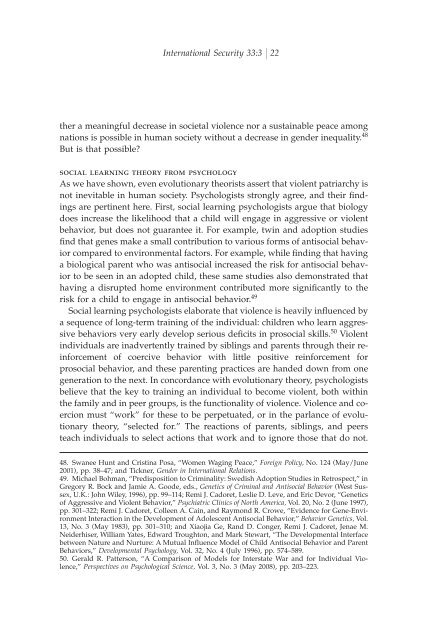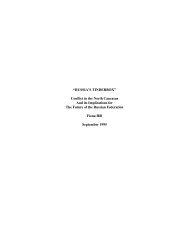The Heart of the Matter Valerie M. Hudson, - MIT Press Journals
The Heart of the Matter Valerie M. Hudson, - MIT Press Journals
The Heart of the Matter Valerie M. Hudson, - MIT Press Journals
You also want an ePaper? Increase the reach of your titles
YUMPU automatically turns print PDFs into web optimized ePapers that Google loves.
International Security 33:3 22<br />
<strong>the</strong>r a meaningful decrease in societal violence nor a sustainable peace among<br />
nations is possible in human society without a decrease in gender inequality. 48<br />
But is that possible?<br />
social learning <strong>the</strong>ory from psychology<br />
As we have shown, even evolutionary <strong>the</strong>orists assert that violent patriarchy is<br />
not inevitable in human society. Psychologists strongly agree, and <strong>the</strong>ir ªndings<br />
are pertinent here. First, social learning psychologists argue that biology<br />
does increase <strong>the</strong> likelihood that a child will engage in aggressive or violent<br />
behavior, but does not guarantee it. For example, twin and adoption studies<br />
ªnd that genes make a small contribution to various forms <strong>of</strong> antisocial behavior<br />
compared to environmental factors. For example, while ªnding that having<br />
a biological parent who was antisocial increased <strong>the</strong> risk for antisocial behavior<br />
to be seen in an adopted child, <strong>the</strong>se same studies also demonstrated that<br />
having a disrupted home environment contributed more signiªcantly to <strong>the</strong><br />
risk for a child to engage in antisocial behavior. 49<br />
Social learning psychologists elaborate that violence is heavily inºuenced by<br />
a sequence <strong>of</strong> long-term training <strong>of</strong> <strong>the</strong> individual: children who learn aggressive<br />
behaviors very early develop serious deªcits in prosocial skills. 50 Violent<br />
individuals are inadvertently trained by siblings and parents through <strong>the</strong>ir reinforcement<br />
<strong>of</strong> coercive behavior with little positive reinforcement for<br />
prosocial behavior, and <strong>the</strong>se parenting practices are handed down from one<br />
generation to <strong>the</strong> next. In concordance with evolutionary <strong>the</strong>ory, psychologists<br />
believe that <strong>the</strong> key to training an individual to become violent, both within<br />
<strong>the</strong> family and in peer groups, is <strong>the</strong> functionality <strong>of</strong> violence. Violence and coercion<br />
must “work” for <strong>the</strong>se to be perpetuated, or in <strong>the</strong> parlance <strong>of</strong> evolutionary<br />
<strong>the</strong>ory, “selected for.” <strong>The</strong> reactions <strong>of</strong> parents, siblings, and peers<br />
teach individuals to select actions that work and to ignore those that do not.<br />
48. Swanee Hunt and Cristina Posa, “Women Waging Peace,” Foreign Policy, No. 124 (May/June<br />
2001), pp. 38–47; and Tickner, Gender in International Relations.<br />
49. Michael Bohman, “Predisposition to Criminality: Swedish Adoption Studies in Retrospect,” in<br />
Gregory R. Bock and Jamie A. Goode, eds., Genetics <strong>of</strong> Criminal and Antisocial Behavior (West Sussex,<br />
U.K.: John Wiley, 1996), pp. 99–114; Remi J. Cadoret, Leslie D. Leve, and Eric Devor, “Genetics<br />
<strong>of</strong> Aggressive and Violent Behavior,” Psychiatric Clinics <strong>of</strong> North America, Vol. 20, No. 2 (June 1997),<br />
pp. 301–322; Remi J. Cadoret, Colleen A. Cain, and Raymond R. Crowe, “Evidence for Gene-Environment<br />
Interaction in <strong>the</strong> Development <strong>of</strong> Adolescent Antisocial Behavior,” Behavior Genetics, Vol.<br />
13, No. 3 (May 1983), pp. 301–310; and Xiaojia Ge, Rand D. Conger, Remi J. Cadoret, Jenae M.<br />
Neiderhiser, William Yates, Edward Troughton, and Mark Stewart, “<strong>The</strong> Developmental Interface<br />
between Nature and Nurture: A Mutual Inºuence Model <strong>of</strong> Child Antisocial Behavior and Parent<br />
Behaviors,” Developmental Psychology, Vol. 32, No. 4 (July 1996), pp. 574–589.<br />
50. Gerald R. Patterson, “A Comparison <strong>of</strong> Models for Interstate War and for Individual Violence,”<br />
Perspectives on Psychological Science, Vol. 3, No. 3 (May 2008), pp. 203–223.
















